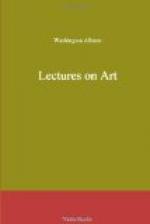It is a common saying, that there is more in a name than we are apt to imagine. And the saying is not without reason; for when the name happens to be the true one, being proved in its application, it becomes no unimportant indicator as to the particular offices for which the thing named was designed. So we find it with respect to the Truth of which we speak; its distinctive epithet marking out to us, as its sphere of action, the mysterious intercourse between man and man; whether the medium consist in words or colors, in thought or form, or in any thing else on which the human agent may impress, be it in a sign only, his own marvellous life. As to the process or modus operandi, it were a vain endeavour to seek it out: that divine secret must ever to man be an humbling darkness. It is enough for him to know that there is that within him which is ever answering to that without, as life to life,—which must be life, and which must be true.
We proceed now to the third characteristic. It has already been stated, in the general definition, what we would be understood to mean by the term Invention, in its particular relation to Art; namely, any unpractised mode of presenting a subject, whether by the combination of forms already known, or by the union and modification of known but fragmentary parts into a new and consistent whole: in both cases tested by the two preceding characteristics.
We shall consider first that division of the subject which stands first in order,—the Invention which consists in the new combination of known forms. This may be said to be governed by its exclusive relation either to what is, or has been, or, when limited by the probable, to what strictly may be. It may therefore be distinguished by the term Natural. But though we so name it, inasmuch as all its forms have their prototypes in the Actual, it must still be remembered that these existing forms do substantially constitute no more than mere parts to be combined into a whole, for which Nature has provided no original. For examples in this, the most comprehensive class, we need not refer to any particular school; they are to be found in all and in every gallery: from the histories of Raffaelle, the landscapes of Claude and Poussin and others, to the familiar scenes of Jan Steen, Ostade, and Brower. In each of these an adherence to the actual, if not strictly observed, is at least supposed in all its parts; not so in the whole, as that relates to the probable; by which we mean such a result as would be true, were the same combination to occur in nature. Nor must we be understood to mean, by adherence to the actual, that one part is to be taken for an exact portrait; we mean only such an imitation as precludes an intentional deviation from already existing and known forms.




